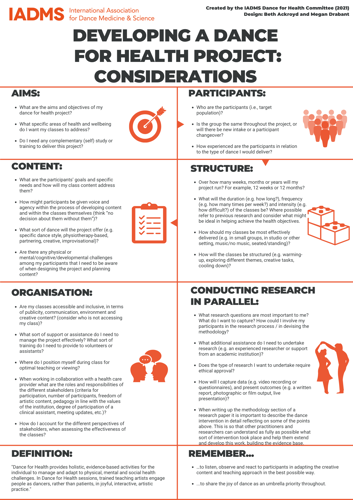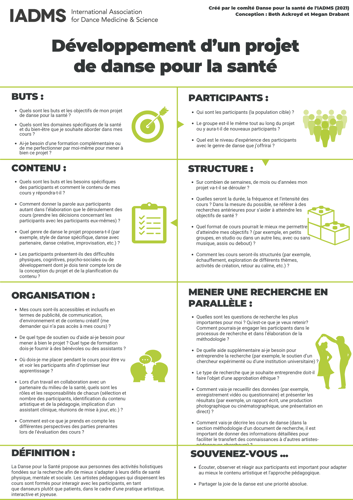Developing a Dance for Health Project: Considerations
Author: The IADMS Dance for Health Committee
It has been exciting to see the growth in the number of teaching-artists delivering dance in participatory settings to promote health and wellbeing among different populations. Alongside this, attempts are being made to capture data from their projects to build evidence of the value of dance as an activity that improves health and wellbeing. As a way of supporting the potential for collaboration between teaching-artists and researchers, the IADMS Dance for Health Committee created a set of guiding questions to help those who are planning dance for health projects in the form of an infographic, available in both English and French.
Here are some of the key considerations highlighted in the infographic:
 When developing a dance for health project, we invite you to consider the following questions: what the aims and objectives are and what specific areas of health and wellbeing you hope to address. You may at this point consider whether you feel you need any complementary (self) study or training to deliver the program.
When developing a dance for health project, we invite you to consider the following questions: what the aims and objectives are and what specific areas of health and wellbeing you hope to address. You may at this point consider whether you feel you need any complementary (self) study or training to deliver the program.
Next, consider who the participants will be in your classes and whether your participants are likely to stay for the duration of the project. Think about how experienced your participants are in relation to the type of dance you will be delivering.
In terms of the structure, think about the duration of your project (i.e., how many weeks, months) and what you hope to achieve in this time (your objectives). How long do you want your classes to be? How will the classes be structured in terms of the content and importantly, how will they progress over time?
Where possible refer to previous research and consider what might be ideal in helping achieve your objectives. Ask yourself how the content of your classes will help meet the goals and specific needs of your participants and reflect on the extent to which you will use creative and exploratory elements versus more instructional and prescriptive components. Are there any physical or mental/cognitive/developmental challenges among your participants that you need to be aware of?
In terms of other organizational aspects, consider how accessible and inclusive your classes
are in terms of publicity, communication, environment, and creative content and think about how best to position yourself in the class for optimal learning.
There are considerations for conducting research alongside any dance for health project. Ask what research questions are most important to you and what you are interested in measuring or capturing. How will you capture these elements (e.g., video, questionnaires, diaries)? Consider how you might involve your participants in the research process.
 Ask whether there is additional assistance you need to undertake the research (e.g., an experienced researcher or support from an academic institution) and whether the type of research you want to undertake requires ethical approval.
Ask whether there is additional assistance you need to undertake the research (e.g., an experienced researcher or support from an academic institution) and whether the type of research you want to undertake requires ethical approval.
When writing up the methodology section of a research paper it is important to describe the dance intervention in detail reflecting on some of the points above. This is so that other teaching-artists and researchers can understand as fully as possible what sort of intervention took place and help them to think about how they might extend and develop this work, building the evidence base.
Remember…
…to share the joy of dance as an umbrella priority throughout.
…to listen, observe and respond to participants and adapt teaching content and approach as necessary.
Download your own copy of the infographic here:
The IADMS Dance for Health Committee is an interdisciplinary team of teaching artists, dance educators, researchers, and healthcare professionals. The committee promotes innovation in research and best practice, bringing together the healthcare and dance sectors to facilitate the implementation of dance-based interventions within evolving health and social structures. Advocating for dance as a life-long partner for health and well-being, the Dance for Health Committee builds collaborations among multidisciplinary stakeholders to influence national and international dance for health policy.
Definition of Dance for Health: Dance for Health provides holistic, evidence-based activities for the individual to manage and adapt to physical, mental, and social health challenges. In Dance for Health sessions, trained teaching artists engage people as dancers, rather than patients, in joyful, interactive, artistic practice.